In today’s digital landscape, email marketing remains a powerful tool for businesses to connect with their audience, drive engagement, and boost conversions. Two popular platforms that have gained significant traction in recent years are ConvertKit and MailerLite. Both offer unique features and capabilities tailored to different user needs, making the choice between them a crucial decision for marketers and content creators alike.
As we delve into the comparison between ConvertKit and MailerLite, we’ll explore their key features, target audiences, and overall performance. This analysis will help you make an informed decision about which platform aligns best with your email marketing goals and business requirements. Additionally, we’ll introduce Prism Reach, an innovative AI-powered solution that can enhance your email marketing efforts beyond what ConvertKit and MailerLite offer.
Key Facts
- Target Audience: ConvertKit is ideal for content creators, while MailerLite caters to small businesses and individual creators.
- Free Plans: Both platforms offer free plans, but MailerLite’s free tier includes more features and a higher subscriber limit.
- Core Capabilities: ConvertKit excels in advanced automation and subscriber management, while MailerLite offers more comprehensive design options and analytics.
Navigating the Email Marketing Landscape: ConvertKit vs MailerLite
When comparing ConvertKit and MailerLite, it’s essential to consider various factors such as ease of use, feature set, pricing, and target audience. Let’s break down these aspects to help you determine which platform might be the best fit for your needs.

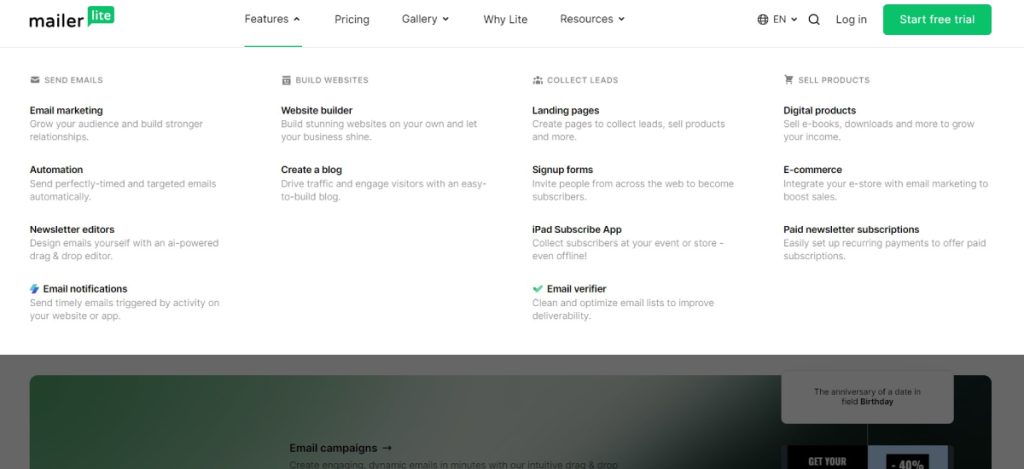
Target Audience and User Interface
ConvertKit: ConvertKit is tailored specifically for content creators such as bloggers, podcasters, and YouTubers. Its user interface, while user-friendly, may require a learning curve for some of its advanced features. As Nathan Barry, founder of ConvertKit, states, “We built ConvertKit to serve creators. Every feature is designed with their specific needs in mind.”
MailerLite: On the other hand, MailerLite is designed for small businesses and individual creators looking for simplicity. Its intuitive and easy-to-navigate interface is particularly suitable for non-technical users. Ilma, CEO of MailerLite, emphasizes, “Our goal is to make email marketing accessible and enjoyable for everyone, regardless of their technical expertise.”
Email Editor and Design Options
ConvertKit: ConvertKit offers a simple, text-based email editor that focuses on plain text for better deliverability. While this approach can be effective, it lacks the drag-and-drop functionality that many users prefer. ConvertKit’s emphasis on simplicity may disappoint users looking for more design flexibility.
MailerLite: MailerLite, in contrast, provides a drag-and-drop editor with support for images, videos, product listings, and even RTL languages. This versatility in design options gives MailerLite an edge for users who prioritize visual appeal in their email campaigns.
ConvertKit:
- Simple, text-based email editor
- Limited design flexibility
- Optimized for better deliverability
- Focus on content creators with minimalist design
MailerLite:
- Versatile design options for visual appeal
- Drag-and-drop email editor
- Support for images, videos, and product listings
- RTL language support
Automation and Segmentation
Automation and segmentation are critical for delivering personalized and relevant content to your audience. Both ConvertKit and MailerLite offer robust options, but with different approaches.
ConvertKit: ConvertKit shines in its advanced automation capabilities, including audience tagging, segmentation, and scoring. Its visual automation builder allows for creating complex workflows, which is particularly useful for content creators with diverse audience segments.
MailerLite: MailerLite also offers a visual automation builder, available even in the free plan, with triggers based on subscriber actions. While not as advanced as ConvertKit’s, it provides flexible segmentation based on 500+ data points, which is impressive for its price point.
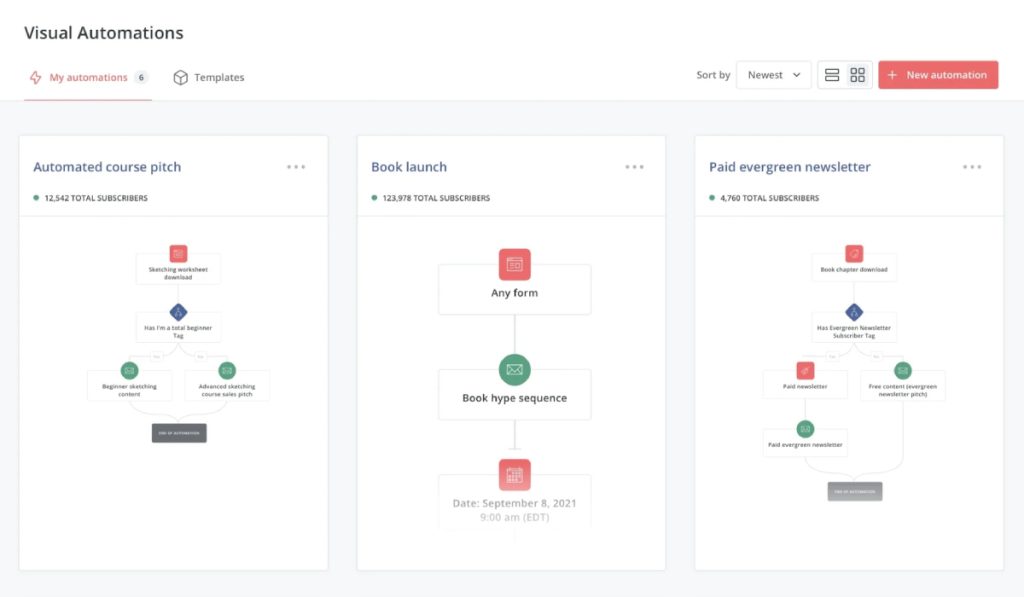
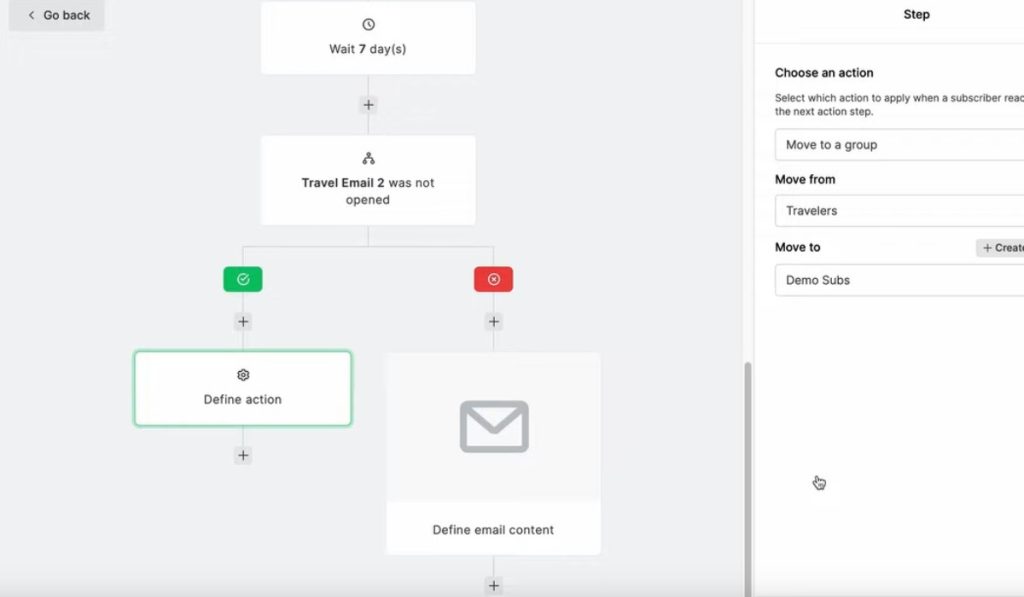
ConvertKit:
- Advanced automation with visual automation builder
- Audience tagging and segmentation
- Lead scoring features
- Automated drip campaigns with sequences
MailerLite:
- Visual automation builder with basic workflows
- Advanced segmentation based on user behavior
- Triggers based on subscriber actions
- Flexible segmentation with over 500 data points
Analytics and Reporting
Effective analytics and reporting tools are essential for measuring the success of your email marketing campaigns and making data-driven decisions.
MailerLite: In terms of analytics, MailerLite takes the lead with comprehensive analytics including open rates, click rates, bounce rates, and heatmaps. Its advanced reporting features interactive maps and detailed visual data presentations, providing valuable insights for data-driven marketers.
ConvertKit: ConvertKit offers basic analytics covering open rates, click rates, and unsubscribes. However, it lacks advanced metrics such as bounce rates and location-based opens, which might be a drawback for users seeking in-depth performance analysis.
ConvertKit:
- Basic analytics: open rates, click rates, unsubscribes
- Limited advanced metrics
- Focus on essential email performance metrics
MailerLite:
- Comprehensive analytics: open rates, click rates, bounce rates
- Heatmaps and interactive maps
- Detailed visual data presentations
- Advanced reporting features for data-driven decisions
Pricing and Value
Pricing is a significant factor in choosing an email marketing platform, and this is where ConvertKit and MailerLite differ considerably. Understanding these pricing models is essential to determine which platform aligns best with your budget and growth plans.
ConvertKit: ConvertKit offers a free plan for up to 1,000 subscribers with unlimited emails but restricted features. Its paid plans start at $29/month for the Creator Pro plan, which includes advanced features like automated funnels, integrations, and priority support. This pricing structure makes ConvertKit more accessible for small businesses and individual creators, while ActiveCampaign’s higher-tier plans cater to larger enterprises with more complex needs.
MailerLite: MailerLite offers a free plan for up to 1,000 subscribers and 12,000 emails per month, including access to most features. Its paid plans start at $15/month for 1,000 subscribers, offering excellent value for money. MailerLite’s pricing is generally more affordable than ConvertKit’s for similar subscriber counts, making it an attractive option for small businesses and those just starting out.

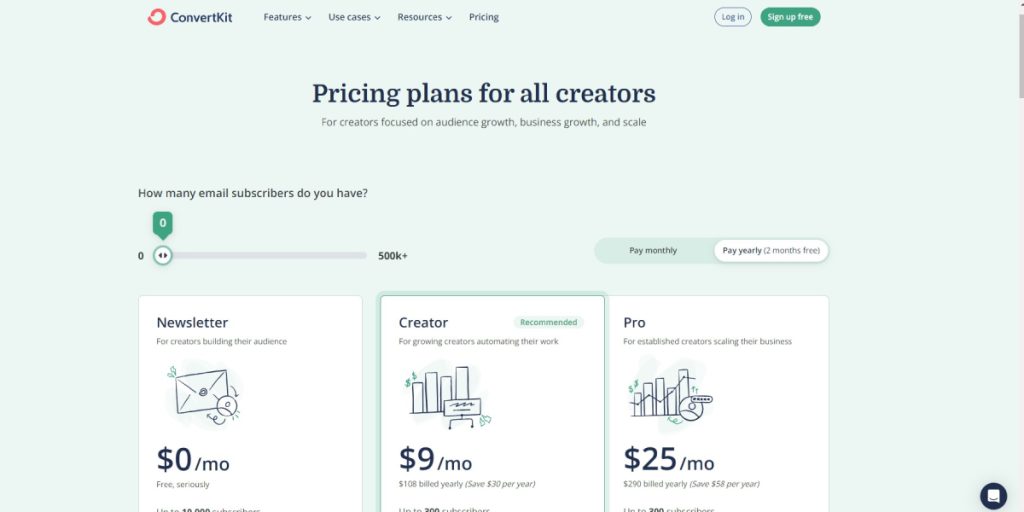
ConvertKit:
- Free Plan: Up to 1,000 subscribers with limited features
- Creator Pro Plan: Starting at $29/month for 1,000 subscribers
- Advanced features: automated funnels, integrations, priority support
- Higher cost for advanced functionalities
MailerLite:
- Free Plan: Up to 1,000 subscribers and 12,000 emails/month
- Paid Plans: Starting at $15/month for 1,000 subscribers
- Access to most features even on free tier
- Affordable pricing for small businesses
Integration Capabilities
The ability to integrate with other tools and platforms is a significant factor when choosing an email marketing service. It ensures that your marketing stack works seamlessly together.
ConvertKit: ConvertKit boasts integrations with over 120 platforms, including e-commerce, membership sites, and course platforms. This wide range of integrations makes it particularly attractive for content creators who use multiple tools in their business ecosystem.
MailerLite: MailerLite offers integrations with more than 140 platforms, including CRM software, e-commerce platforms, and form builders. Additionally, it supports Zapier integrations, allowing connections to thousands of other apps, providing small businesses with ample opportunities to connect their existing tools with their email marketing efforts.
ConvertKit Integrations:
- Over 120 app integrations
- E-commerce platforms like Shopify
- Membership sites and course platforms
- Integration with Zapier for extended connectivity
MailerLite Integrations:
- Over 140 app integrations
- CRM software and e-commerce platforms
- Form builders and landing page tools
- Seamless integration with Zapier for thousands of additional apps
Customer Support and Resources
Both platforms pride themselves on excellent customer support, but there are some differences in their offerings.
ConvertKit: ConvertKit offers responsive support and extensive documentation, which can be particularly helpful for users navigating its more advanced features. Their support channels include email and live chat, with priority support available on higher-tier plans.
MailerLite: MailerLite provides 24/7 support via email and chat, with high responsiveness. This round-the-clock availability can be a significant advantage for users operating across different time zones or those who need assistance outside of regular business hours. Additionally, MailerLite offers a comprehensive knowledge base and tutorial resources to help users maximize their email marketing efforts.
ConvertKit:
- Responsive email and live chat support
- Extensive documentation and tutorials
- Priority support on higher-tier plans
- Community forums for additional help
MailerLite:
- 24/7 email and chat support
- Comprehensive knowledge base
- Tutorials and how-to guides
- High responsiveness and assistance availability
Deliverability and Compliance
Both ConvertKit and MailerLite boast high deliverability rates, supported by DKIM authentication and anti-spam policies. They also offer tools to help users comply with data protection regulations like GDPR, which is crucial in today’s privacy-conscious digital landscape.
ConvertKit: ConvertKit’s focus on plain-text emails may give it a slight edge in deliverability, as these types of emails are less likely to trigger spam filters. This emphasis on simplicity ensures that your emails reach the intended recipients without unnecessary barriers.
MailerLite: MailerLite also maintains high deliverability rates, with robust tools and practices in place to ensure compliance and maximize inbox placement. Its advanced segmentation and targeting further contribute to higher engagement rates, positively impacting deliverability over time.
ConvertKit:
- High deliverability rates with plain-text email focus
- DKIM authentication and anti-spam policies
- Tools for GDPR compliance
MailerLite:
- Compliance tools for GDPR and other regulations
- High deliverability rates with robust practices
- Advanced segmentation and targeting to boost engagement
Hidden Gems: Lesser-Known but Highly Effective Strategies
While ConvertKit and MailerLite are renowned for their core functionalities, there are several hidden gems within each platform that can significantly enhance your email marketing efforts. Integrating these strategies can provide a competitive edge and drive better results.
1. Utilize Advanced Segmentation in MailerLite
MailerLite allows you to segment your audience based on user behavior, such as engagement levels and purchase history. This feature can help you create highly targeted campaigns that resonate with specific subscriber groups, leading to improved engagement and conversion rates.
2. Leverage ConvertKit’s Visual Automation Builder
ConvertKit’s visual automation builder allows you to create complex email sequences easily. This feature can be underutilized; by mapping out your customer journey visually, you can better understand how to nurture leads through targeted content.
3. Incorporate Surveys and Quizzes in Emails
MailerLite provides tools for creating surveys and quizzes directly within your emails. This interactive content can engage subscribers and provide valuable insights into their preferences, which can inform future marketing strategies.
4. Use Custom HTML Blocks in MailerLite
For users with coding skills, MailerLite allows the addition of custom HTML blocks in emails. This flexibility enables you to create unique designs or functionalities that stand out from standard templates.
5. Implement Drip Campaigns with ConvertKit’s Sequences
ConvertKit’s email sequences allow for automated drip campaigns that can nurture leads over time. By setting up a series of emails that gradually introduce your audience to your brand or product, you can maintain engagement without constant manual effort.
Innovative Solutions by Prism Reach
While ConvertKit and MailerLite offer robust email marketing solutions, Prism Reach introduces a groundbreaking approach to newsletter personalization. Leveraging advanced AI technology, Prism Reach creates hyper-personalized newsletters tailored to individual subscriber interests.

Benefits of Prism Reach
- AI-Powered Personalization: Prism Reach leverages AI to create detailed user avatars, enabling hyper-personalized content delivery that goes beyond traditional mass email campaigns.
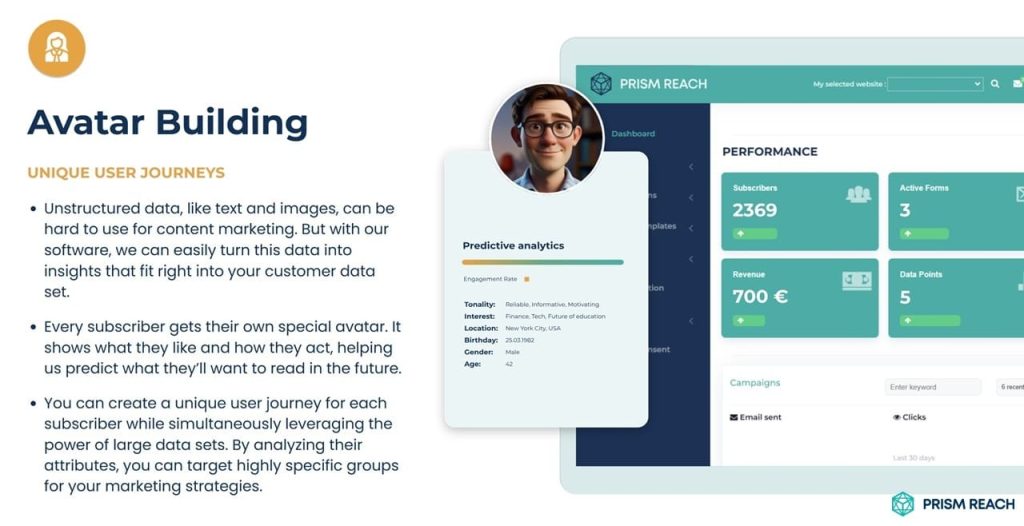

- Dynamic Content Selection: Ensures each subscriber receives the most relevant content based on their behavior and preferences, enhancing engagement and conversion rates.
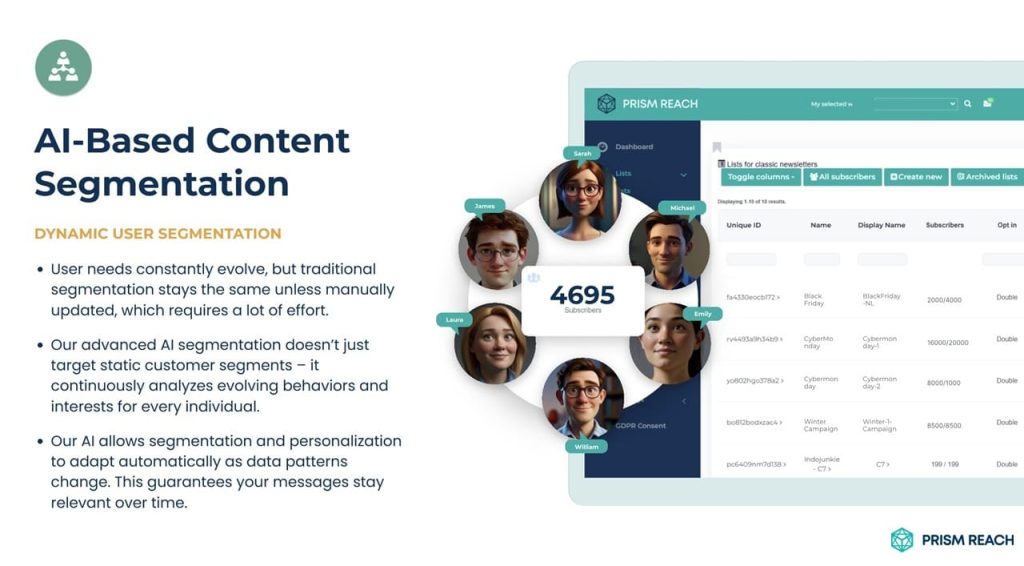
- Seamless Integration: Easily integrates with ConvertKit and MailerLite, allowing businesses to leverage Prism Reach’s advanced features without overhauling their existing systems.
Integrating Prism Reach with ConvertKit and MailerLite
Businesses can leverage Prism Reach alongside ConvertKit or MailerLite to enhance their email marketing strategies. For instance, using Prism Reach’s AI-powered personalization with ConvertKit’s advanced segmentation can create highly targeted and effective campaigns.
Similarly, integrating Prism Reach with MailerLite’s comprehensive design and segmentation tools can provide deeper insights into subscriber behavior, allowing for more informed marketing decisions and optimized content delivery.
Practical Tips and Considerations
To maximize the effectiveness of your email marketing efforts, consider the following practical tips and strategies:
1. Leverage Behavioral Segmentation
Instead of traditional demographic segmentation, use behavioral data to target customers based on their actions (e.g., browsing history, past purchases). ActiveCampaign’s advanced behavioral segmentation ensures your messages are highly relevant and timely, leading to better engagement.
- Behavioral Segmentation: Ensures relevance and timeliness of messages.
- Conditional Content: Tailor content blocks based on user behavior.
- Dynamic Content: Display personalized product recommendations.
2. Automate Social Media Posts
MailerLite allows users to automate social media posts alongside email campaigns. By coordinating messaging across channels, businesses can reinforce their marketing efforts and maintain consistent brand messaging.
- Consistent Messaging: Reinforces marketing efforts across channels.
- Time-Saving Automation: Reduces manual effort in posting.
- Enhanced Brand Presence: Maintains a consistent brand image.
3. Incorporate SMS Marketing
Many businesses overlook SMS as a marketing channel. MailerLite supports SMS marketing, allowing you to reach customers directly on their mobile devices with time-sensitive offers or updates, which can lead to higher engagement rates compared to email alone.
- Direct Communication: Reaches customers on their mobile devices.
- Higher Engagement Rates: SMS has higher open rates compared to email.
- Urgency and Timeliness: Perfect for flash sales and time-sensitive promotions.
Potential Benefits of Prism Reach
- AI-Powered Personalization: Enhances email content relevance, driving higher engagement rates.
- Dynamic Content Selection: Ensures each subscriber receives the most relevant content based on their behavior and preferences.
- Seamless Integration: Easily integrates with ConvertKit and MailerLite, allowing businesses to leverage Prism Reach’s advanced features without overhauling their existing systems.
Upgrade Your Email Marketing with AI Personalization!
FAQ
Conclusion
In the ConvertKit vs MailerLite debate, the choice ultimately depends on your specific needs and goals. ConvertKit is an excellent choice for content creators who prioritize advanced automation and subscriber management. Its focus on simplicity and effectiveness in email marketing for creators is commendable.
MailerLite, with its user-friendly interface, comprehensive design options, and robust analytics, offers great value for small businesses and individual creators. Its generous free plan and affordable pricing make it an attractive option for those just starting their email marketing journey.
However, for businesses seeking cutting-edge personalization and automated content curation, Prism Reach presents an innovative alternative. By leveraging advanced AI technology to create hyper-personalized newsletters, Prism Reach offers a unique solution that could revolutionize how businesses approach email marketing. Integrating Prism Reach with ConvertKit or MailerLite can provide a synergistic effect, enhancing personalization, dynamic content delivery, and overall campaign effectiveness.
Ultimately, the best choice will depend on your specific requirements, technical expertise, and budget. Consider your priorities, test the platforms, and choose the solution that best aligns with your email marketing strategy and business goals. By carefully considering the strengths and weaknesses of each platform, you can make an informed decision that will drive your email marketing success.
Sources
- MailerLite vs ConvertKit Comparison. (n.d.). Mailmodo. Retrieved from https://www.mailmodo.com/comparison/mailerlite-vs-convertkit-vs-mailmodo/
- ConvertKit Alternative. (n.d.). MailerLite. Retrieved from https://www.mailerlite.com/convertkit-alternative
- MailerLite vs ConvertKit. (n.d.). Gbolahan Ajayi. Retrieved from https://gbolahanajayi.com/mailerlite-vs-convertkit
- MailerLite vs ConvertKit. (n.d.). Website Planet. Retrieved from https://www.websiteplanet.com/blog/mailerlite-vs-convertkit/
- MailerLite vs ConvertKit Compared – Which Is Better? (n.d.). WebsiteBuilderly. Retrieved from https://www.websitebuilderly.com/convertkit-vs-mailerlite/